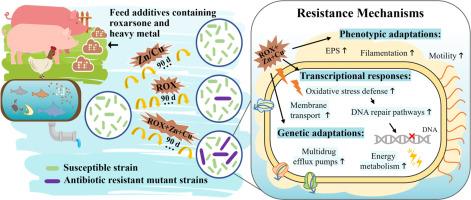Environmental co-exposure to roxarsone and heavy metals drives bacterial antibiotic multidrug resistance via genetic and phenotypic adaptations
IF 12.4
1区 环境科学与生态学
Q1 ENGINEERING, ENVIRONMENTAL
引用次数: 0
Abstract
Agricultural wastewater, a significant component of the anthropogenic water cycle, often contains complex mixtures of contaminants, including non-antibiotic feed additives, posing largely uncharacterized risks for antimicrobial resistance (AMR) evolution. This study addresses the critical knowledge gap regarding the combined impact of commonly co-occurring roxarsone (ROX) and heavy metals (Zn, Cu) at environmentally relevant concentrations on the de novo evolution and persistence of multidrug resistance in aquatic environments. Using a 90-day laboratory evolution experiment with Escherichia coli, we demonstrate that while ROX alone induced moderate resistance (e.g., 6.2-fold increase in minimum inhibitory concentration (MIC) for chloramphenicol), co-exposure with Zn and Cu synergistically drove multidrug tolerance to nine antibiotics and selected for stable, heritable resistance to chloramphenicol, tetracycline, and kanamycin (up to 8.2-fold MIC increase). This robust resistance persisted even after pollutant removal, highlighting a significant long-term threat to water quality and public health via the dissemination of resilient AMR bacteria from agricultural sources. Co-exposure intensified oxidative stress-induced mutagenesis and selected for key adaptive strategies enhancing bacterial survival and AMR persistence in contaminated water. These include upregulated efflux pumps, increased secretion of extracellular polymeric substances (1.1-3.2-fold), enhanced motility (1.1-1.5-fold), and cell filamentation (lengths 2.4-8.2-fold greater). These findings illuminate a potent, previously underestimated environmental pathway where mixtures of common agricultural pollutants in wastewater synergistically select for persistent multidrug resistance. This research underscores the urgent need to revise water quality criteria and wastewater treatment paradigms to address the co-selection pressures exerted by non-antibiotic chemical mixtures in aquatic ecosystems.

洛克沙酮和重金属的环境共同暴露通过遗传和表型适应驱动细菌抗生素多药耐药
农业废水是人为水循环的重要组成部分,通常含有复杂的污染物混合物,包括非抗生素饲料添加剂,对抗菌素耐药性(AMR)的演变构成很大程度上未知的风险。本研究解决了在环境相关浓度下常见的洛克沙酮(ROX)和重金属(Zn, Cu)对水生环境中多药耐药的新生进化和持续存在的综合影响方面的关键知识缺口。通过对大肠杆菌进行为期90天的实验室进化实验,我们发现,虽然ROX单独诱导了适度的耐药性(例如,对氯霉素的最低抑制浓度(MIC)增加6.2倍),但与Zn和Cu共同暴露协同驱动了对9种抗生素的多药耐受性,并选择了对氯霉素、四环素和卡那霉素的稳定、可遗传的耐药性(MIC增加8.2倍)。即使在去除污染物后,这种强大的耐药性仍然存在,突出表明,通过农业来源的抗菌素耐药性细菌的传播,对水质和公众健康构成了重大的长期威胁。共暴露增强了氧化应激诱导的诱变,并选择了提高污染水中细菌存活和抗菌素耐药性持久性的关键适应策略。这些包括外排泵上调、细胞外聚合物质分泌增加(1.1-3.2倍)、运动增强(1.1-1.5倍)和细胞丝化(长度增加2.4-8.2倍)。这些发现阐明了一个强有力的、以前被低估的环境途径,即废水中常见农业污染物的混合物协同选择持久的多药耐药性。这项研究强调了迫切需要修改水质标准和废水处理范例,以解决非抗生素化学混合物在水生生态系统中施加的共同选择压力。
本文章由计算机程序翻译,如有差异,请以英文原文为准。
求助全文
约1分钟内获得全文
求助全文
来源期刊

Water Research
环境科学-工程:环境
CiteScore
20.80
自引率
9.40%
发文量
1307
审稿时长
38 days
期刊介绍:
Water Research, along with its open access companion journal Water Research X, serves as a platform for publishing original research papers covering various aspects of the science and technology related to the anthropogenic water cycle, water quality, and its management worldwide. The audience targeted by the journal comprises biologists, chemical engineers, chemists, civil engineers, environmental engineers, limnologists, and microbiologists. The scope of the journal include:
•Treatment processes for water and wastewaters (municipal, agricultural, industrial, and on-site treatment), including resource recovery and residuals management;
•Urban hydrology including sewer systems, stormwater management, and green infrastructure;
•Drinking water treatment and distribution;
•Potable and non-potable water reuse;
•Sanitation, public health, and risk assessment;
•Anaerobic digestion, solid and hazardous waste management, including source characterization and the effects and control of leachates and gaseous emissions;
•Contaminants (chemical, microbial, anthropogenic particles such as nanoparticles or microplastics) and related water quality sensing, monitoring, fate, and assessment;
•Anthropogenic impacts on inland, tidal, coastal and urban waters, focusing on surface and ground waters, and point and non-point sources of pollution;
•Environmental restoration, linked to surface water, groundwater and groundwater remediation;
•Analysis of the interfaces between sediments and water, and between water and atmosphere, focusing specifically on anthropogenic impacts;
•Mathematical modelling, systems analysis, machine learning, and beneficial use of big data related to the anthropogenic water cycle;
•Socio-economic, policy, and regulations studies.
 求助内容:
求助内容: 应助结果提醒方式:
应助结果提醒方式:


